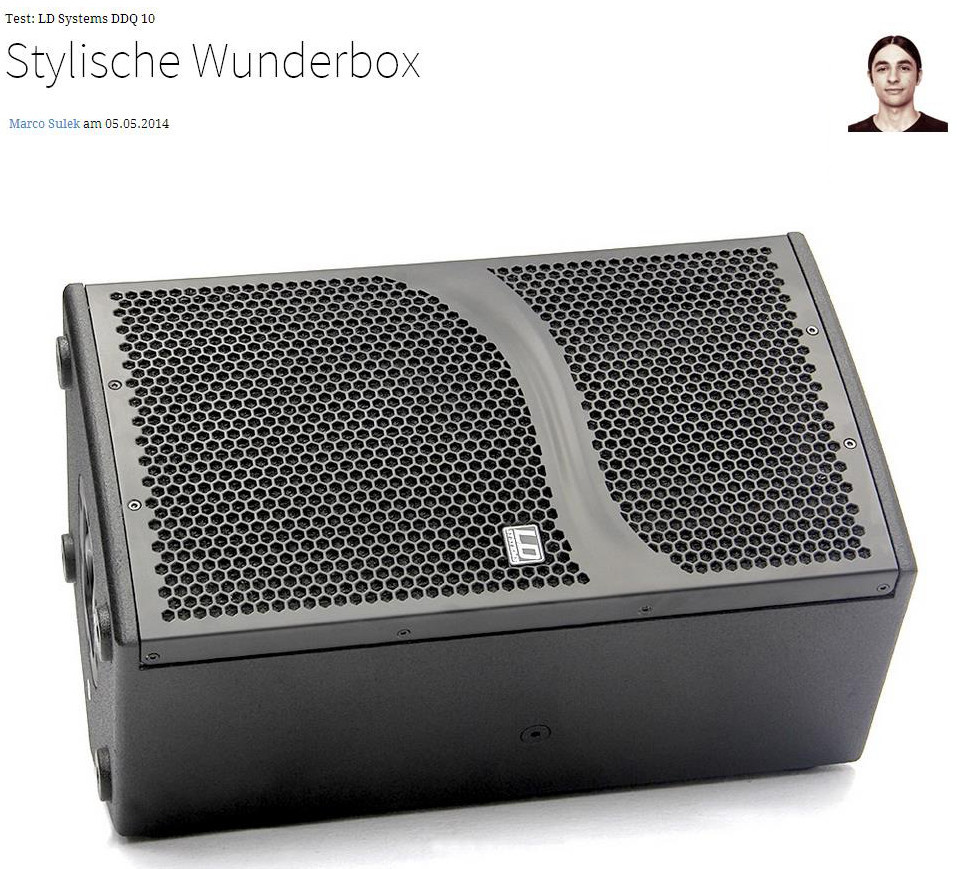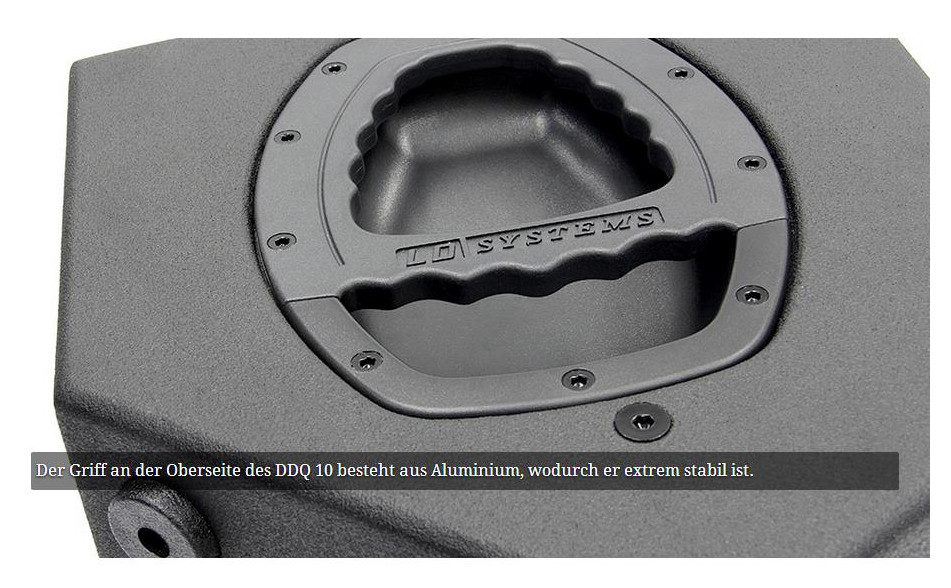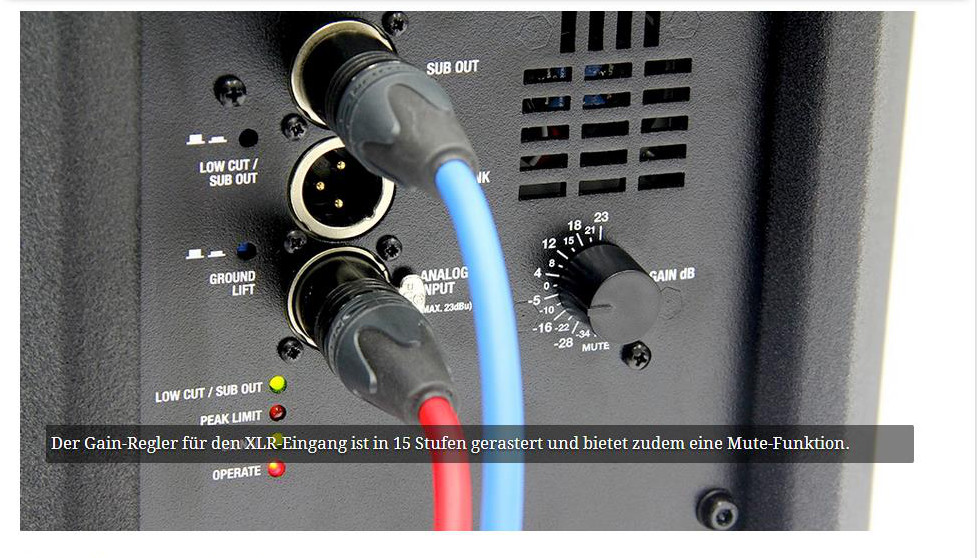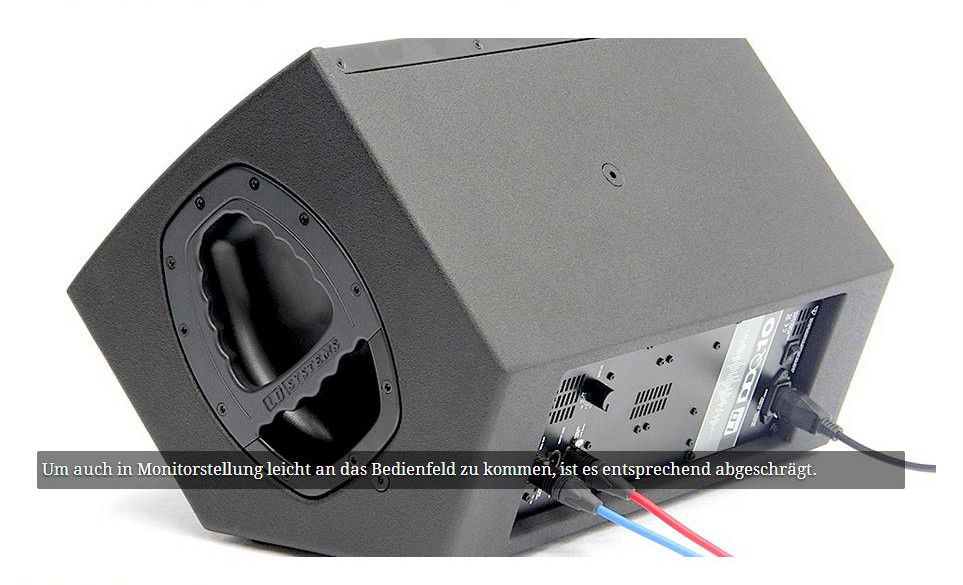LD Systems DDQ 10 – stylish wonder box – Product review by musicnstuff.de
Meanwhile, the DDQ series from LD Systems comprises all relevant speaker sizes for mobile live use – all in active design. We had the compact DDQ 10 to test as part of the top league of manufacturers. 
High quality and professional speakers for live operation usually look quite unspectacular at first glance. They are just simple black boxes. However, they know how to convince through their sonic qualities and their robustness – not in vain does it say: “only the inner values count.” The DDQ 10 from LD Systems is one of these fairly nondescript, but stable and acoustically exemplary crafted devices. However, it does look more sophisticated than some of its competitors.
As a design nuance, the front grille of the DDQ 10 shows a sweeping wave that optically separates the high tone section of the woofer. In the centre right, appears the metal LD Systems logo. The grille itself consists of black, honeycomb-shaped punched-out steel – and is therefore virtually indestructible. A fine plastic mesh protects the drivers against the penetration of foreign objects. The cabinet made of 15 mm thick birch promises even more robustness and longevity. A durable finish prevents unsightly scratches.
The shell handle at the top of the box is also quite stable: The so-called Evolutive handle is made of aluminium, the shell itself is made of plastic – both are extremely tightly screwed. The tripod flange represents a peculiarity: This can be adjusted in 4.5° increments to the individual sound situation. To do this, you can lift the speaker somewhat to release the locking mechanism, and then put it down again at an angle of maximum ±13, 5 °. In addition, the DDQ 10 has four M8 mounting points to allow for suspension of the speakers.
In order for the LD Systems 10″ to be used as a monitor, the multi-function cabinet is tilted at a 50° angle on the back. Four rubber feet ensure a non-slip grip on the stage floor. We appreciate the fact that the speaker does not immediately topple when a musician puts his foot on it: some manufacturers would do well to draw inspiration from that. In terms of craftsmanship and robustness, the DDQ 10 convinces all along the line.

Starline
LD Systems has packed a lot of components from renowned manufacturers into the DDQ 10, as many as is possible to fit inside a speaker: the tweeter comes from the German compression driver specialists BMS. To ensure a dispersion angle of 80° x 60° in monitor position for the asymmetrical horn, it can be turned by 90°. However, you must remove the front grille to make this adjustment.
The woofer is a 10″ driver from Italian company Faital Pro. This comes with a neodymium magnet, which is much lighter in contrast to ferrite counterparts – on the other hand, it also costs quite a bit more. Since the DDQ 10 is a bass reflex system, there are also appropriate openings. So, left and right next to the high frequency horn, vents have been inserted to strengthen the bass reproduction.
As power amplifiers, two models from the Dutch manufacturer Hypex were used: The Class-D power amplifier UCD400, in duplicate, ensures that both tweeter and woofer each provide 400 watts (RMS) – and that is impressive, considering that it is a very compact acoustic solution. With this configuration, a maximum sound pressure level of 132 dB at a frequency response of 59 Hz to 20 kHz can be achieved – but for the tonal qualities, refer to comments below.
The converters of the built-in SHARC DSP provide a proud 127 dB dynamic range – which is far more than the human ear can bear. The conversion is achieved for 24 bits at 48 Khz. The processor takes over the signal processing as well as all protection features that are necessary for a professional and trouble-free operation. For example, the limiter comes with a look-ahead time of one millisecond to ensure that peak levels don’t cause any harm for the power amplifiers or speakers.

As Simple as it is Effective
At the back of the DDQ 10, the connection and control panel can be found. This is kept very simple: A total of four sockets, three switches and a controller – that’s it. More is not necessary. This is where the designers at LD Systems have thought ahead: in order to provide the user with easy access in the monitor position, the control panel is slightly tilted. This is useful, because if the DDQ 10 is arranged with a horizontal angle of 50°, it would otherwise be difficult to adjust other settings.
The DDQ 10 receives signals via an XLR-input, which is of course balanced. Although it is commonplace in the professional to only use this format, it would have been preferable to have at least a combo input as well. A Gain controller ensures that the volume of the input is fed directly to the speaker. This is adjustable in 15 increments – which helps you configure two identical models. In addition, the potentiometer offers a mute function when positioned at “six o’clock”.
Two additional XLR jacks feed the signal to other speakers or amplifiers. The upper is designed for the connection of a subwoofer and also has a Lowcut – or X-Over switch. This separates the signal with a slope of 18 dB at 100 Hz – the DDQ 10 plays back everything above that level and the sub then only has to play the low frequency remainder. If the switch is not activated, it loops the input signal one to one, just like the Link-Out switch located below.
Four LEDs enable a visual inspection: as soon as the DDQ 10 is in standby mode, the lower LED shows “Operate” in red. The signal LED will turn green when an input signal with a signal level of at least -30 dBu is present. The last two indicators “Peak Limit” and “Lowcut/Sub Out” should be self-explanatory. All LEDs flash when the maximum input level is exceeded, so that one should turn down the input signal accordingly to avoid ugly distortions.

Simply Stunning
We come to the phonetic aspects of the LD Systems DDQ 10. One positive thing is immediately noticeable: the bass response. Despite the relatively modest dimensions and equipment, the 10″ system reaches pretty far down – without sound mash, but well differentiated, and crisp. So, the speakers represent an ideal sound solution for smaller venues, whether in fixed installations or mobile use, for small gigs and parties – and even without an additional subwoofer.
In addition to the regular bass, the other frequency ranges are also convincing: The mids feel as if they had been lowered a little and sound appropriately unobtrusive; the highs are brilliant, but not aggressive. Judging from the playback detail and depth, it feels rather like this is actually a hearty studio speaker. Another very positive aspect is the feedback resistance: even at sound pressure levels, where other speakers emit deafening screeches, the DDQ 10 remains true.
Since PA speakers are usually operated at loud volumes, the ground noise is unlikely to be significant, still, it is relatively negligible. The LD Systems DDQ 10, however, is far below the noise level of many competitors – even in the same price range. So it could almost be used for live events with powerful levels, as well as for the domestic living room sound at low volumes. Should there be – regardless of its origin – an annoying hum, a ground lift feature fortunately provides help.
With the DDQ 10, LD Systems offers a compact, professional multi-function speaker with first class craftsmanship and playback quality – and furthermore “Made in Germany”. The 10″ system is not only ideal for live sound for audiences and musicians, but also for fixed installations and even the high demands of the rehearsal room. And also reason to celebrate: where many manufacturers skimp with long cables, LD Systems offers a three metre long power cable – as it should be.

Rating:
+ extremely robust
+ excellent sound
+ high quality craftsmanship
+ ground-lift
+ very low noise
– only one XLR input
Price (RRP): € 1,099
Distribution: Adam Hall
For further information, see:
http://www.ld-systems.com/en/series/ddq-series/ddq-10-10-inch-active-pa-speaker-with-dsp/
Source: http://www.musicnstuff.de/ , Germany, May 2014
Author: Marco Sulek Sulek graduated with a Bachelor of Arts in audio production at the SAE Munich; he is a musician and offers a mobile recording service. Since 2011, he has been working as a technical editor in the field of audio engineering.
Leave a Comment
You must be logged in to post a comment.












